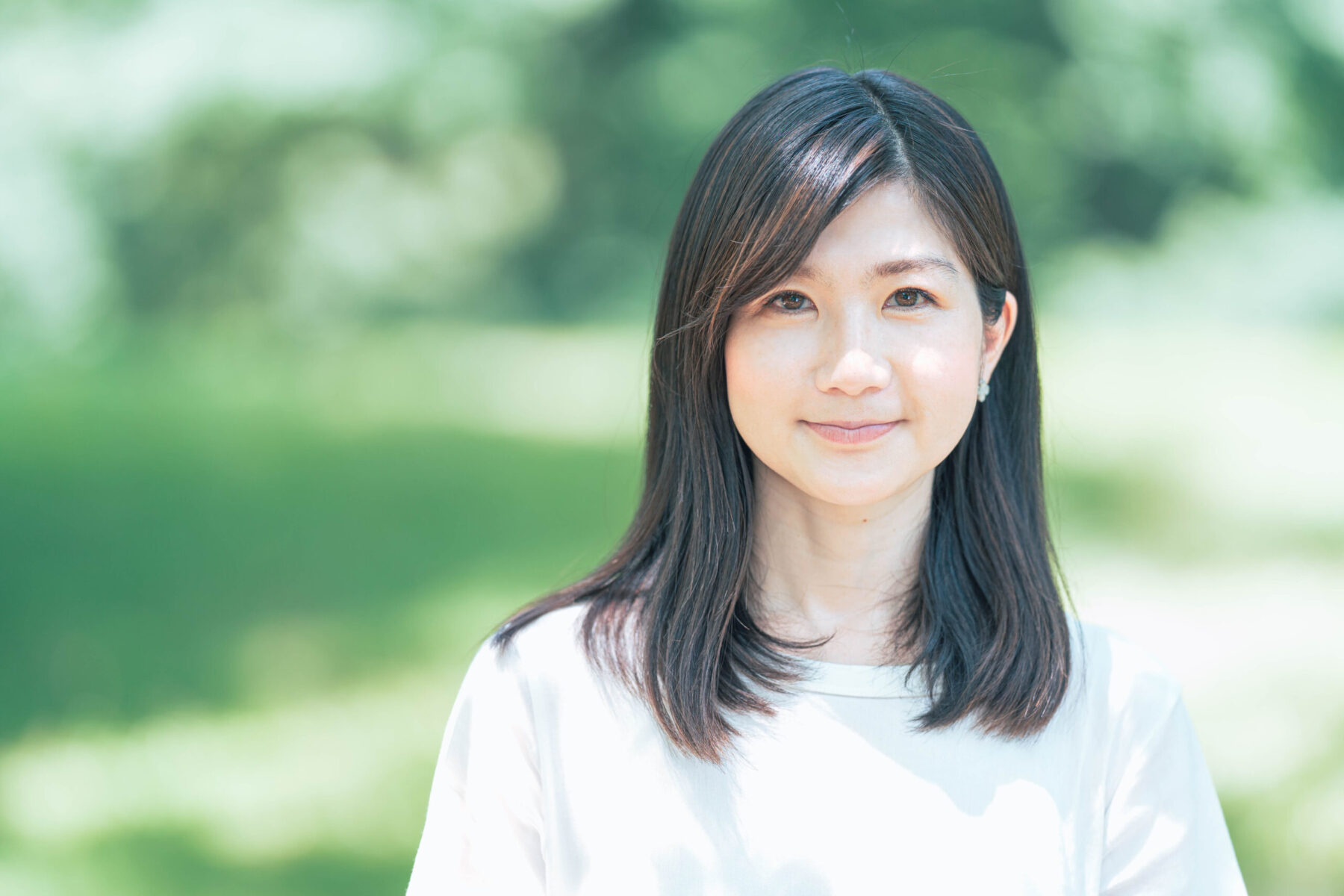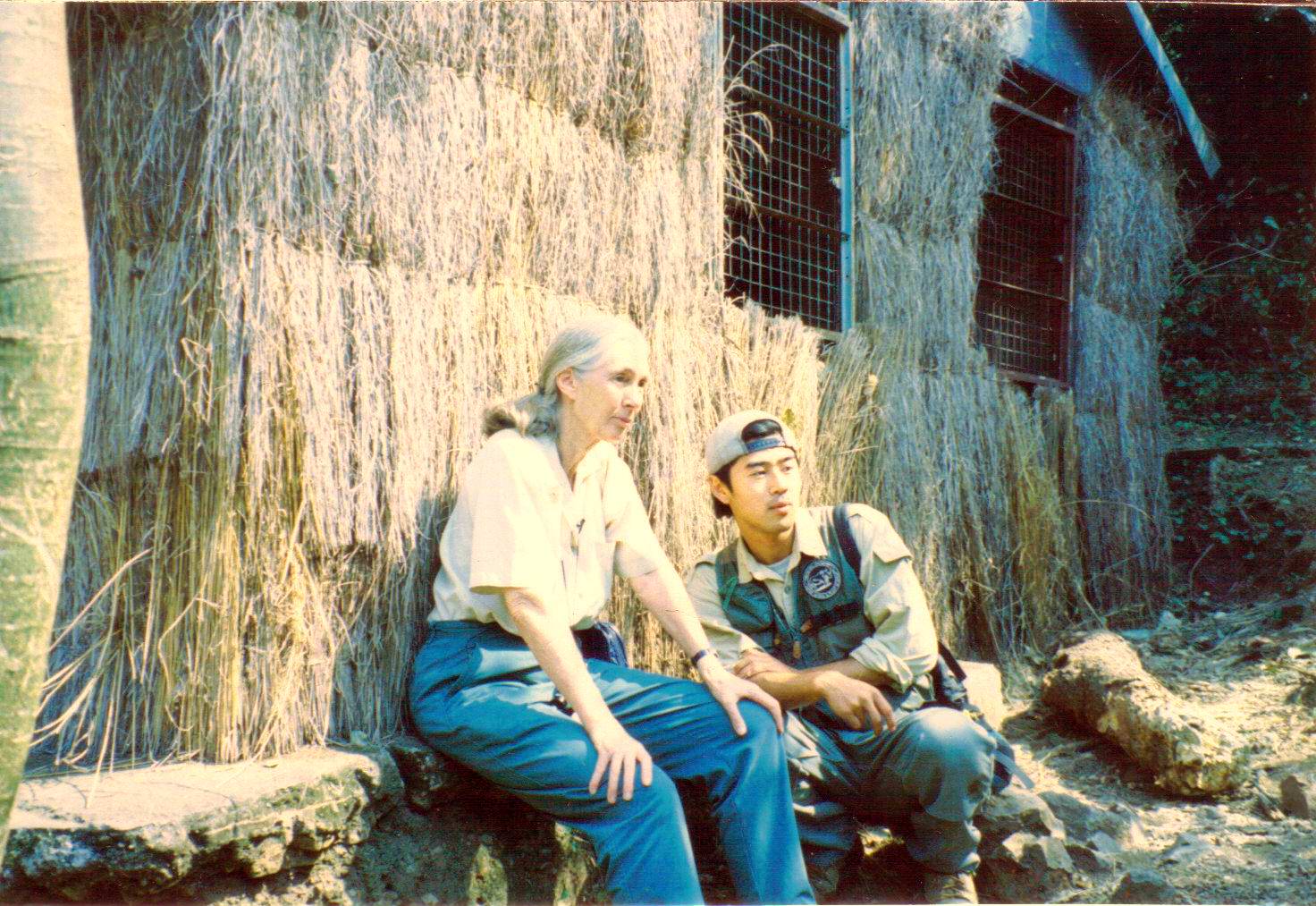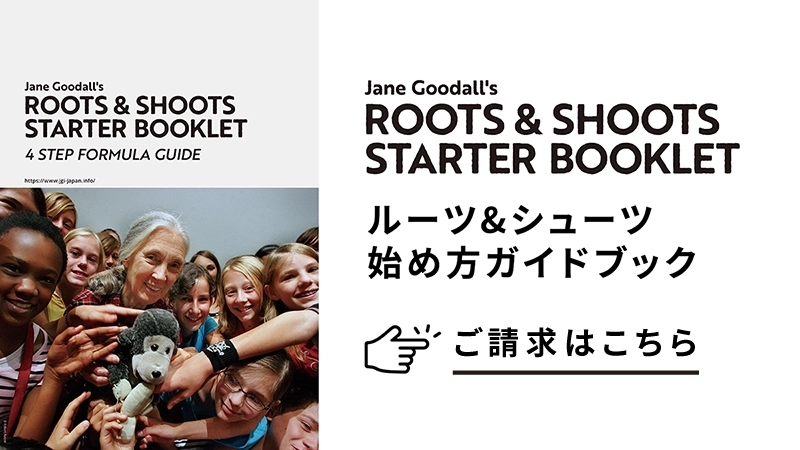vol. 001
初回は気象予報士の井田寛子さん──「気象予報士として、気候変動のことをもっと伝えたい」 Hiroko Ida──"As a weather forecaster, I aim to shed more light on the topic of climate change."

「人の心を動かすもの──それはストーリーです」
これは、ジェーン・グドール博士が常々口にする言葉。そこでジェーン・グドール・インスティテュート ジャパンは、自然環境活動や動物保護活動などに心血を注ぐ人々にスポットをあてた新連載企画「Jane & Me」をスタート。「人」「動物」そして「自然」が共生する平和な世界につながっていくための“希望”を育み、“行動”へと繋げていくために、同じ想いをともにする方々のストーリーテリングを展開していきます。
第一回目は、気象予報士でキャスターの井田寛子(いだひろこ)さんです。テレビで見たことがある人も多いのではないでしょうか。「気象予報士として、気候変動のことをもっと伝えたい」──そんな思いから、現在クライメート・エデュケーターとして、気象の知識と気候の知見を繋いで発信していく活動をしています。
ルーツ&シューツのグループの若者たちから集まったたくさんの質問をベースに、インタビューを実施しました。
──なぜ気象予報士に?
小さい頃からの伏線としては、すごく自然や生き物が好きだというところが繋がってると思うんです。キャスターとしてテレビ局で働き始めたのは、自然番組などを通して自分の“好き”を生かした発信がしたいと思ったから。そして最初に赴任した静岡は、台風が頻繁に襲来する地域で、災害が発生すると報道の全てが切り替わる現場を目の当たりにしました。自然界のもつ美しさだけでなく、その怖さを目撃し、自然災害から人の命を守ることが、メディアがまず第一にしなければいけないことだと実感したのです。その頃から自然災害について一専門家として何か発信したいと思い、気象予報士の資格を取得しました。
──実際に気象予報士になってから、気候変動を伝えることにどんな難しさを感じましたか?
私が気象予報士として仕事を始めた2008年ごろは、日本でも地球温暖化についての報道が高まり、「電気を消しましょう」「公共の交通機関を使いましょう」といったライフスタイルの中で始められるエコ活動が盛んに呼びかけられるようになりました。でも、当時は災害と地球温暖化についての直接的な報道はあまりされていませんでした。そんな中、2011年に東日本大震災が起こり、福島第一原発の事故からエネルギーへの関心が高まり、さらには経験したことのない暑さだったり、雨の降り方も激しくなったりで、目に見えて災害が激甚化しているのを誰もが感じるようになりました。しかし、災害報道が最優先で、それを気候変動に結びつけて伝えることは難しく、私自身も確信が持てずにいました。ですがその後の10年で、自然災害と気候変動の関係が科学的に裏付けられ、根拠が強化されました。これにより、「自然災害の背後にある気候変動や地球温暖化を正確に伝えたい」という思いに自信が持てるようになりました。
──どんな科学的データが後押しに?
私たち気象予報士は気候科学者ではないので、気候の科学的なデータを読み込んで伝えるしかありません。ですから、専門家がたくさんの論文を提出して査読を繰り返して作られるIPCCの報告書から得られるものは大きく、人為的要因によって気温が上がっていることが科学的に証明されたことや、地球温暖化が極端な気象に与えた影響を数値で表す「イベント・アトリビューション」という科学的な解析手法も発表されたことで、根拠をもとに話すことができるようになりました。
──インスピレーションとなったものとは?
COP21のパリ協定を控えていた2014年に、ニューヨークで開催された「国連気候サミット」に番組の取材で行ったことが、気候変動をもっと踏み込んで伝えたいと思う大きなきっかけの一つです。そのときにアメリカ、ヨーロッパ、アジアなど、世界中から気象予報士が集結し、気候の科学者を交えたワークショップが行われました。すると、みんな同じように日々の天気や災害は伝えているけれど、気候変動については十分に伝えられていないという共通の悩みを抱えていました。その理由としては、放送の時間が十分になかったり、上司の理解が得られなかったり、自分たちが科学者ではないがためにメディアで発言していいものなのかという葛藤を抱えていたり──。でもその一方で、実は科学者の方々は私たちにそこを求めていることがわかりました。科学者は知見はあれど日々伝える立場にはなく、難しいことを噛み砕いて発信することがあまり得意ではないという声もあり、伝え手のプロである気象予報士に期待するところでもあったんです。
──今はクライメート・エデュケーターとしてどのようなことをされているのでしょうか?
一つは、メディアの伝え方を変えることです。現状、自然災害が発生すると、その事実をタイムリーに報じることで止まってしまい、「気候変動についても伝える」という一歩踏み込んだアプローチができていません。そこで大学院に入り、研究のテーマとして過去15年間分のテレビのデータを全部集めて分析しました。するとやはり気象と気候変動の絡みを全然伝えられていないことが可視化されました。そしてメディアの人たちの中には、このままじゃダメだと思っている人が少なからずいることもわかりました。こうした調査を通じて、気象と気候危機に関する番組を制作する仲間を増やしたり、日々の気象情報の中で気候変動についての発言を増やすよう働きかけたりしています。他にも企業や自治体に対しても、気象予報士として自分が得た知見を伝えていく取り組みを行っています。
さらにこれからは、自然に対する敏感さや考える柔軟性を持つ子どもたちへも何か伝えていけたらいいなと思っています。近くの生き物、植物、花も含めて、身近にあるものを観察する力を子どもたちは持っています。楽しみながら生き物や自然の変化を感じ取り記録し、今までとは違った時期に飛ぶ蝶々やてんとう虫を観察してみることや、桜の咲く時期について考えてみることなどができたらいいなと考えています。
──ご自身が子どものころに育まれた自然への思いを胸に、今は専門性を生かしながら人々を巻き込んで気候危機対策に取り組まれていることなど、ジェーン・グドール博士と通ずるものがあると感じます。
私は幼少期から大学受験までは獣医になりたかったという夢もあったので、ジェーン博士のように自身の「好き」と「熱意」を形にできていることを心から尊敬します。これまで私は気象や科学的な側面から気候危機について学びを深めてきましたが、学べば学ぶほど、政治や政策面の要素の大きさと課題の複雑さを知りました。そしてこれを変えていかないと、守りたいものを守れないということも。彼女のように多角的に行動して社会に貢献できるっていうのはなかなかないと思いますし、意思の強い人だと感じます。
──そもそも天気予報はどうやって行っているのでしょうか? 天気の予測と気候変動の予測の違いとは?
明日、明後日の天気予報を外すのに、何十年、何百年先の予測はなぜできるのかという質問をよく寄せられるのですが、それは気象と気候の違いなんです。気象は数日先の予報や週間予報のレベルで、日本の精度としても8割程度当てられる技術が発達しています。過去の気象観測データを使ってスーパーコンピューターで計算すると、地球の大気や海洋、陸地の状態の変化を予測することができ、これらの数値から明日や数日先、1週間先等の予報を出します。最近はスーパーコンピューターの精度や気象衛星等を使った観測の技術も向上しているので、その分天気予報も良く当たるようになりました。
一方で、何十年先に気候が暑くなるかどうかといった気候の将来予測は、コンピューター上で地球を再現した「気候モデル」を用います。人為的要因によって発生した温室効果ガスを含む場合、含まない場合の比較を計算すると、温暖化によってどの程度気温が上がりそうなのかを予測することができます。例えば、2050年の1月1日の天気をあてることはできないけれど、確率として天気がこういう傾向にあるということはシミュレーションで予測ができます。気象と気候はスケールや予測の手法も大きく異なるものなんです。
──今年の日本の夏は、記録的な暑さとなりました。これは異常気象なのでしょうか? また、日本の気候はどう変化していると思いますか?
「異常気象」という言葉には定義があり、30年に一回程度発生する現象なんです。なので、異常気象とは自然変動のことで、人為的なものが左右しているわけではなく、エルニーニョやラニーニャといった地球の中にある自然変動の中で記録的な数字が出たりします。しかし地球温暖化は、その異常気象の頻度を上げてしまうため、30年に一回発生するはずのものが10年に一回になったり数値が跳ね上がったりします。今年の暑さは、エルニーニョも重なり、地球温暖化も底上げしているので、異常気象であるとともに長い時間をかけて変化してきた気候の姿を表すものではないかと思います。
地球は熱くなるし、日本も大雨の頻度が上がり、災害リスクが増えていることは間違い無いことですよね。でも、絶望することばかりではなく、私はポジティブな面を伝えていくことも大事だと思っています。例えば、2050年までに世界の平均気温上昇を産業革命前に比べて1.5度未満に抑えなければいけないことは事実であり難しいことなのですが、同時に、これを実現できれば現状維持ができることを証明しています。こうした科学的な根拠によって、政治が動き、国の政策が変わり、企業も人も変化してきました。それは大きな希望だと言えると思います。自然界が織りなす美しい営みを慈しみ、次世代へと継承していくために、困難な課題をポジティブな発想へと転換させ、その解決に向けて積極的に取り組むことが、伝え手として大切にしているところです。
──趣味はヴィーガン料理だと。始められた経緯は?
10年ほど前から毎日1時間ヨガをするようになり、体の中のバランスを整える上でもヴィーガンの食事を好んで食べるようにもなりました。また、野菜や果物が好きで野菜ソムリエの資格やローフードを勉強していた時期があり、有機野菜や果物の味の濃さやおいしさに魅了されていきました。植物性の食材だけで充分に美味しく、それに加えて動物性の成分が一切ないことで、ヴィーガン料理は野菜の風味が一段と際立つと感じ、さらに環境にも優しいならなお良しだなと思いました。その後、子どもが生まれてからもソイミートの唐揚げを作るなどしていたのですが、押し付けるのではなく選択肢のひとつとして提示できたらと思い、今はフレキシブルな食事を心がけています。子どもたちとの食卓でのコミュニケーションのひとつとして、クリスマスにヴィーガンケーキを選んで買うなど、食のいろんなバリエーションを知ってもらいたいと考えています。
──ご自身のモチベーションとなっているものとは?
気象のことを理解した上で、気候の知見を繋いで伝えることは私たちがやらなきゃいけないことです。人や情報の点と点を線で繋ぐことをまだ誰もやっていないし、私自身がやりたい。やり遂げたいことが目の前にあることが、私のモチベーションになっています。
そしてもう一つ、それはやはり子どもたちの存在です。子育てをしながらも、美しい山や空を見ると、子どもたちの熱量が上がり、さまざまな表情を見せてくれます。しかし、昨今の夏は遊べる場所が限られてきてしまうなど、最近では生命にかかわる天気となっています。私たちが見て感じてきた綺麗なものを失うのは、あまりに寂しいことです。美しいものを子どもたちに見せ続けたいと強く感じます。
Questions by: Roots & Shoots Saint Mary’s International School, Roots & Shoots Yokohama International School
Photo: Courtesy of Hiroko Ida
Coordination: Asami Yamamoto
Interview & Text: Mina Oba
“To change one’s attitude, you’ve got to reach the heart. And I do that through storytelling”──Dr. Jane Goodall
Inspired by her words of hope, the Jane Goodall Institute Japan launched a new interview series called “Jane & Me”. We are interviewing environmental conservationists, activists, scientists, (and more!) who share Jane’s wisdom, and focusing on individuals dedicating their efforts to build a world where humans, animals, and nature coexist in harmony.
Our very first changemaking guest is Hiroko Ida, a familiar face to many as a television weather forecaster. “As a weather forecaster, I aim to shed more light on the topic of climate change.” says Hiroko. Driven by her curiosity and compassion, she now works as a Climate Educator, bridging meteorological knowledge with insights into climate change and shares her knowledge with others.
We conducted the interview based on the many questions gathered from the youth members of the Roots & Shoots group. Join us and get curious as Hiroko’s stories help us to grow our compassion and take action to build a better world.
──How did you end up becoming a weather forecaster?
Since I was a child, I have loved nature and animals. I started my career as a TV reporter, because I wanted to share my love of nature and wildlife with others. I was initially assigned to Shizuoka, an area prone to frequent typhoons, and it was there that I experienced how, when a natural disaster occurs, all news coverage shifts to this theme. I realized that the natural world is not only beautiful, but also has great power, and that protecting human lives from natural disasters must be the foremost responsibility of the media. Since then, I have endeavored to become an expert on natural disasters so I might be able to share more knowledge, which led me to obtain qualifications as a weather forecaster.
──As a weather forecaster, what have been the challenges you’ve faced in reporting on climate change?
In 2008, when I started my career as a weather forecaster, there was a growing focus on climate change in Japan. Initiatives promoting eco-friendly lifestyle choices (such as turning off the lights, using public transportation, etc.) gained momentum. However, it was not so common for the media to make the connection between natural disasters and climate change at that time. Then, the Tohoku Earthquake and Fukushima disaster occurred in 2011, bringing energy issues to the fore. On top of this, unprecedented heatwaves and heavy rain struck across Japan, making it apparent to everyone that natural disasters were increasing in severity.
Despite this, reporting on the natural disasters themselves was the priority, and communicating the link between them and climate change was more challenging. I, for one, struggled with a lack of confidence in my ability to report accurately on the topic. However, over the subsequent decade, scientific research has advanced and as a result I have gained confidence and a desire to report on the connection between climate change, global warming and natural disasters.
──What scientific data did you refer to?
We are not climate scientists, so we rely on interpreting scientific data about the climate. We were able to substantiate much of our information from the IPCC reports, generated by numerous research papers and which showed us that the temperature was rising because of human activity. Additionally, we’ve seen the introduction of scientific analytical methods such as ‘Event Attribution’, which quantifies the impact of global warming on extreme weather events. This evidence enables us to now speak with confidence.
──What inspired you to care about climate change?
One of the main reasons I wanted to take a more in-depth look at climate change was when I went to the UN Climate Summit in 2014, just before COP21 (where the Paris Agreement was signed) was about to take place. During that event, weather reporters around the globe gathered for workshops that were held with climate scientists. There, we realized that there was a shared concern that, despite everyone consistently reporting on the daily weather, climate change was not being adequately reported upon. The reasons included insufficient broadcast time, a lack of understanding from colleagues and superiors, and uncertainty as to whether non-scientists like us should be speaking about climate change in the media.
On the other hand, it became apparent that scientists were actually seeking our help. They had the knowledge, but they did not have a regular platform to share their knowledge with a wider audience, and also struggled to simplify complex information for these audiences. There was, in fact, an expectation that we as reporters and communication professionals could fulfill this role.
──What is your role as a Climate Educator?
One is to change the way the media communicates. Currently, when natural disasters occur, the reporting often ends with keeping up with and sharing the most urgent facts, as opposed to delving into the relationship with climate change. To address this, I entered graduate school and conducted research by collecting and analyzing 15 years of television data. The analysis revealed a clear lack of communication regarding the relation of weather and climate change. I also discovered that there are individuals within the media who recognize the inadequacy of the current approach. I have used this research as an opportunity to increase the number of colleagues producing TV programs that connect weather to the climate crisis, and to advocate for increasing discussion on climate change in daily weather reports. In addition, I have engaged in initiatives to share the insights I’ve gained as a journalist and researcher with corporations and local governments.
I also hope to convey something meaningful to children who possess sensitivity towards nature and flexibility in their thinking. Children inherently have the ability to observe and enjoy things around them, whether that be animals, plants, and flowers that surround us. They are the greatest researchers who can explore the changes happening in nature, such as the appearance of butterflies and ladybugs, reflecting on the season of cherry blossoms blooming, and so on.
──It is truly wonderful to see how you have connected your childhood passion towards nature to your current profession. What aspects of Dr. Jane inspire you?
My other dream was to become a veterinarian, so I deeply admire Dr. Jane’s ability to translate her ‘interests’ and ‘passions’ into tangible accomplishments. The more I learn about climate change, the more I realize the big role that politics plays and the complexity of the challenges we face. Without making political changes, we cannot protect what we cherish. Dr. Jane’s ability to take holistic action and contribute to society in such a comprehensive manner is such a remarkable accomplishment.
──How do you predict the weather? What is the difference between weather forecasting and predicting climate change?
That is a very good question. I often receive questions about why we can make predictions about the weather for decades or centuries ahead even though sometimes the forecast for tomorrow is off the mark. This is about the differences between weather and climate. Weather forecasting can predict conditions for the next few days or weeks. In Japan, the technology achieves accuracy rates of approximately 80%. Using past weather observation data and supercomputers for calculations, it is possible to predict changes in the Earth’s atmosphere, oceans, and land conditions. From these numerical analyses, forecasts for the next few days can be generated. The accuracy of supercomputers and advancements in observation technologies, such as weather satellites, have improved, and consequently, weather forecasts have become more reliable.
On the other hand, future climate predictions, such as whether the climate will become hotter in the next few decades, utilize “climate models” to simulate changes in the Earth’s climate. By comparing scenarios with and without anthropogenic factors, including greenhouse gas emissions, these models can predict the extent to which temperatures are likely to rise due to global warming. While it may not be possible to predict the weather on January 1, 2050, simulations can provide forecasts in terms of probabilities, indicating trends and patterns. It’s important to note that weather and climate science involve significantly different scales and forecasting methods.
──This year Japan had the longest, hottest Summer on record and the hottest November day on record. In your opinion, are these weather extremes anomalies for this year or do you think that the climate in Japan is changing?
The term abnormal weather has a defined meaning and refers to phenomena that occur approximately once every 30 years. Therefore, abnormal weather is a result of natural variations and is not influenced by human activities; rather, it arises from inherent fluctuations within the Earth, such as occurrences like El Niño or La Niña. However, global warming increases the frequency of such abnormal weather events, causing occurrences that were expected once every 30 years to happen every 10 years. The heat that we experienced this year was compounded by the influence of El Niño and exacerbated by global warming. This abnormal weather also reveals the gradual transformation of our climate over a long period.
It is undeniable that the Earth is warming, and in Japan, the frequency of heavy rainfall is increasing, elevating the risk of disasters. However, I believe it’s important to focus on the positive aspects as well. For instance, we must limit the global average temperature increase to less than 1.5 degrees compared to pre-industrial levels by 2050. This also means that we have the ability to maintain the current state if we can change our actions. Scientific evidence like this has prompted political action, accelerated the sustainable transformation in business, and brought about innovation in many fields. This brings me hope. To cherish the tapestry of nature and pass it on to the next generation, I think it’s important, especially as someone in my field of work, to reframe challenging issues in a positive light and actively participate in finding and developing solutions.
──Your profile states that you like vegan cooking. What sparked your interest?
Yoga became part of my daily routine a decade ago, and it helped me to realize that my body feels better on a vegan diet. Additionally, my interest toward vegetables and fruits led me to study as a Vegetable Sommelier and explore raw food. The richness and deliciousness of organic vegetables and fruits captivated me. I found that vegan cuisine allows the flavors of vegetables to stand out even more. I also embraced the idea that vegan dishes are not only delicious but also beneficial for the planet. After becoming a parent, I continued to have dishes like soy meat tempura, but now I maintain a flexible approach to meals to give my children an opportunity to choose on their own. As part of communication at the table, I introduce various food options, such as choosing a vegan cake for Christmas, to expose them to a diverse range of culinary experiences.
──What motivates you to take action?
Understanding the weather and connecting the insights of climate is something we must do. No one has yet done this, and it is something I want to achieve. This goal is my motivation.
And another important factor is my children – the next generation. Through parenting, I witness my children’s fascinated expressions when they see the beauty of the mountains and the sky. However, the summers have become too hot, limiting the places they can play. This breaks my heart and I strongly feel the need to pass on the miracles of Earth to the next generation.
Questions by: Roots & Shoots Saint Mary’s International School, Roots & Shoots Yokohama International School
Photo: Courtesy of Hiroko Ida
Coordination: Asami Yamamoto
Interview & Text: Mina Oba
Editor: Mariko McTier


